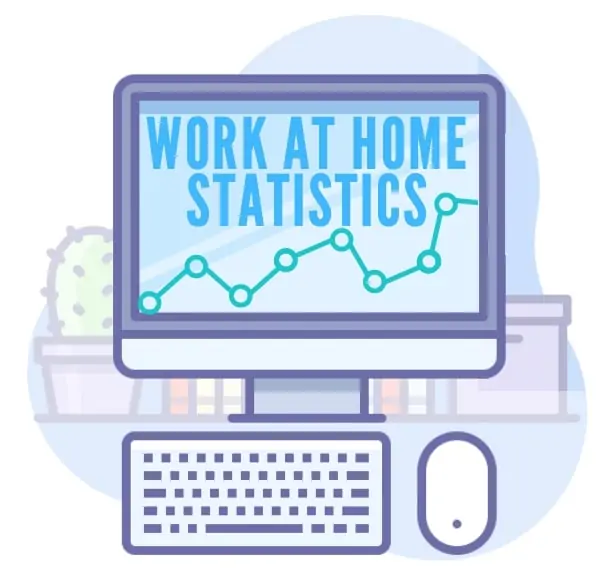Work From Home Statistics (All you need to know!)


As currently one of the most sought-after benefits that a company can offer, flexible style remote working is becoming more popular and is set to see even more growth in the coming years.
With such a tidal shift in the way we work, I have rounded up some staggering work from home statistics of 2024 that are quite compelling.
Below, I have cove such categories as growth areas, demographics, remote working with big business, salaries, life balance, and more. Let’s begin!
Work From Home Statistics 2024 (All you need to know!)

Key Work From Home Statistics
Here are some of the key remote working statistics extracted from this article. Read more below for different categories of statistics to learn about remote working growth, the future outlook, as well as salary trends for remote workers across different industries.
- A flexible schedule is said to be the greatest benefit of remote working for 40% of remote employees.
- 43% of employees in the United States work remotely for at least a portion of their working lives.
- In 2020 there were already 7 million people in the United States working remotely. This was before the pandemic of COVID-19 forced even more people to take up remote working.
- The number of people working remotely has grown by 44% during the last 5 years, and that number will increase drastically taking into account 2020’s remote working shift with the COVID-19 pandemic.
- Businesses that have remote working as part of their company culture generally experience 25% less employee turnover.
- 16% of companies only hire remote workers.
- 82% of workers would like to work from home at least one day per working week.
- 57% of workers desire to work from home at least three days per working week.
- It’s more common for larger companies to offer remote working options than smaller companies.
- $44 billion USD is saved each year collectively by employers who offer telecommuting as a work option at least part-time.
Growth & Demographics Of Remote Working

As with any industry, there are standout demographics and locations that are at the forefront of remote working. Below are some key statistics and findings that relate to areas that are growing with work at home jobs.
- Since 2010, the number of people working from home at least once a week has grown by 400%.
- Recent statistics in 2020 report that 5 million employees work from home at least half of the time. This is 3.6% of the United States workforce.
- Since 2005, the number of work at home telecommuting employees (apart from self-employed workers) has grown by 173%.
- In the space of just one year – between 2017 and 2018 – the amount of telecommunication grew by 22%.
- There are 81% more entirely remote working companies in South America than anywhere else in the world.
- South American employees work remotely 67% more than people around the world.
- Interestingly, South American and Asian markets also have 9% more companies that do not allow remote work than the worldwide average.
- Australia has a 60% market of hybrid companies (remote and onsite).
- Africa also has a high hybrid company percentage, at 59%.
- Remote working jobs in America are most abundant in Texas, New York, and California.
- States in America that have a growing number of remote working companies are also North Carolina, Minnesota, and Massachusetts.
Businesses & Work From Home Facts

Companies that provide remote working options don’t just benefit from higher employee satisfaction, but also higher productivity leading to a greater chance of business success.
Take a look at the business impact of this style of work in the following remote working statistics.
- 65% of employees believe that they would be more productive in their roles in a home office than a traditional work office space.
- Employers seem to agree with the statistic above, as 2/3 of managers who offer the flexibility for workers to be remote claim that employees who work from home are more productive overall.
- 75% of remote workers state that fewer distractions are why they are more productive in their remote working.
- 69% of workers claim that technology advancements have made them more productive, although 25% of those workers fear that they will be replaced in the future by technology – namely, automation software.
- 2/3 employers report higher productivity in remote workers compared to in-office workers.
- Globally, 44% of companies don’t allow remote working options at all.
- 16% of businesses only hire remote workers.
- 18% of people working remotely do so on a full-time basis.
- 52% of workers around the world will work from home at least one day per week.
- 62% of workers who are remote at least some of the time fear that onsite employees may be judging them as not working as hard.
Top Work At Home Jobs Statistics

Below is a breakdown of industries that take part in remote working, as well as the key departments within companies that tend to offer remote working more than other departments.
Of course, there will be some industries that are physically unable to offer remote working, just as some jobs are a great fit for this style of work.
- Industries that have the most workers who are remote are healthcare (15%), internet and technology (10%), financial businesses (9%), education (8%), and manufacturing (7%).
- The majority of people working remotely in different industries hold management positions, at 16%.
- Office and administrative support workers in various industries make up 14% of remote workers.
- Sales employees make 13% of the remote working pool.
- Employers for sales jobs will hire 66% more remote workers than the average of other departments.
- Financial and business operations make up 9% of remote workers.
- Computer and mathematical systems workers also make up 9% of remote workers.
- 18% of executives will work remotely more than they do on-site.
- Some industries will never be able to have remote workers, such as plumbing.
- When it comes to vacation time for remote workers, 32% of remote workers actually get unlimited vacation, though most of them don’t use it.
- Generally, remote workers take about 2-3 weeks of vacation time per year.
Remote Working Salary and Financial Statistics

If you’re wondering how remote working can affect how much an employee makes, the following remote working statistics might surprise you.
It seems that salary is not negatively affected by remote working, but can actually be higher in some cases for remote workers.
- The median earnings for a work-from-home employee in 2018 was $42,442 USD a year, which was above the median earnings for the entire pool of all workers, which was $38,184 USD.
- The average annual income for remote workers is $4,000 USD more than non-remote workers.
- It’s estimated that remote workers save from $4,000 to $7,000 USD a year in their lifestyle. This takes into account on-site work expenses and travel costs.
- 71% of companies say that they don’t compensate remote worker’s use of coworking spaces for their remote employees.
- 75% of companies report that they wouldn’t compensate remote workers for their internet usage.
- 18% of employees state that their employer does cover their internet expenses.
- 7% of remote workers report that their employer covers some a partial cost of their internet usage for work.
- Remote workers are earning salaries over $100,000 USD a year 2.2 times more than on-site workers earning that amount.
- 24% of workers in the United States say that they would take a pay cut of up to 5% so that they could work remotely.
- 68% of remote workers are not concerned that working in this way will impact their career progression.
- 23% of remote workers fear that this working-style may impact their career progression.
Work From Home Life-Balance & Challenges

Though employees experience many benefits of working remotely, there are also some challenges which people face as a result of working from home (or just out of the office).
Read these key work-life balance remote working statistics to learn the pros and cons of remote working.
- The main reason remote workers choose this lifestyle is for a better work-life balance, at 91%.
- 79% of remote workers also claimed that increased focus and productivity was why they chose to enter into remote working.
- Less stress (78%) and to avoid having to commute (78%) were also top reasons for remote workers choosing this working lifestyle.
- 84% of remote workers much prefer to work remotely from their homes.
- A small percentage (8%) of remote workers actually choose to use a coworking space for their work.
- 4% of remote workers choose to work in cafes.
- 0.5% of remote workers use libraries as their workspace.
- Only 3% of remote workers feel that they are less productive working from home.
- Employees who identify with having a physical learning style, which is based on simulation and experience-based learning, are 56% more likely to go entirely remote in their work.
- 77% of people surveyed believed that having a flexible job would enhance their health, from eating better to exercising more.
- 86% of employees claim that remote working would allow them to be less stressed.
- Over 1/3 of remote workers say that they do so in order to care for their children.
- 22% of remote workers state that their biggest issue with remote working is how to unplug after they have finished work.
- 17% of remote workers feel that it impacts on their effective collaboration and communication with coworkers, despite the video conferencing and team-based software available.
- Brainstorming meetings are flagged as some of the more challenging collaborative meetings for remote working employees.
- Loneliness during work is another issue for 18% of remote workers, though compared to 86% of workers who enjoy working on their own, it is not the majority.
- 85% of workers would expect their company to provide them with the means to work remotely and feel it would be difficult if companies did not.
The Future Of Remote Working/ Work From Home Statistics

These remote working statistics shed light on the future outlook of remote working, which is very much impacted by the advancements of technology and the globalization of business and industries.
- 42% of employees with an option to work remotely plan to take part in remote working more often in the next 5 years.
- 37% of employees will opt to take a 10% cut to their pay if it means being able to continue working from home.
- 99% of the current workers who are taking part in remote work at least part of the time desire to continue this way of work for the rest of their careers.
- The advances in remote software tools like mobile working applications and virtual and augmented reality conferencing are why many experts predict that remote working will become more widespread across many industries.
- By the year 2028, 73% of all industries will have remote workers.
- The future of the environment looks bright with more remote working, as it’s estimated that 3.6 million tons of commuting-related air pollution (greenhouse gasses) is being saved annually in the United States.
- There is some competition for company-employed remote workers, as it’s said that by 2027, freelance workers will be the majority of the workforce in the United States.
- 44% of companies continue to resist the remote working trend, though how they may shift in the future seems to be pointing towards adopting this style of working as the growth-rate worldwide continues.
- It’s anticipated that technology-based roles are where big growth in remote working will happen, with computer programming, machine learning, robotics, and engineering are advancing rapidly across many industries.
To learn more, you can also see my guide on the top digital nomad jobs and also online learning statistics to further your career.
